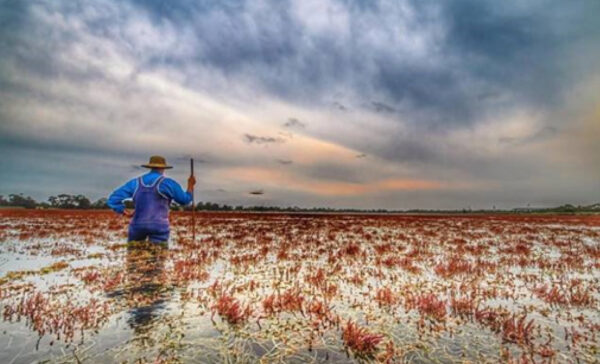In recent months visitors to Altona’s Cherry Lake will likely have noticed a reddish, russet-coloured bloom covering much of the water’s surface.
Given the lake’s sad recent history they might have been thinking ‘here we go again, more pollution.’
For many, memories of the fish kill that occurred in March 2022 are still vivid. Introduced carp and native fish were gasping for life on the surface, lolling listlessly in the reeds, piling up in pockets of the lake where wind and water flows could take them no further.
The cause was a chemical spill from a nearby factory that entered the drains running into Cherry Creek, which feeds the lake. Around twenty tonnes of dead fish were removed.
In the weeks and months that followed, a dark pall seemed to hang above the lake. The anglers were gone, picnickers were few and the birds seemed fewer still. Staked signs advised people to avoid contact with the water.
Happily, two years on it couldn’t be more different. The bloom presently there is not the effect of pollution, it’s the native Red Watermilfoil. Not quite a household name, but it ought to be.
Ben English, manager of Melbourne Water’s Waterway and Catchment Services Team based in Werribee, is excited about the positive changes this plant is making to the lake’s ecology.
“It is really pleasing to see a burst of Red Watermilfoil on Cherry Lake at the moment,” says Ben. “This is a native aquatic plant that helps clean the water by filtering sediments and nutrients as well as providing fantastic habitat for native bugs. These bugs provide a good source of food for birds so this is why people are probably seeing a lot more birds at Cherry Lake at the moment.”

Red Watermilfoil lives just below the water’s surface, shooting up its spiky flowers. But why is this plant that Melbourne Water celebrates as ‘the best thing that has happened to the natural environment on Cherry Lake for some time’ germinating now?
Ben suggests the absence of a large carp population, a consequence of the chemical spill, could be one of the reasons.
Of course, Cherry Lake is itself artificial. The area, originally a flood plain, was by the 1960s leveed, bulldozed and dammed to create what’s there now.
But let’s be thankful for it. Sometimes humans can alter the natural world and leave behind an asset.
The lake is an asset for native flora and fauna. It nurtures a wonderful array of bird and aquatic life. Revegetation and new tree plantings in the lake’s surrounds will provide the vital canopy we’ll need in the years ahead.
And for the residents to its south the lake is a massive buffer against the industries and roads to its north. Walkers, cyclists and pram pushers love the place.
However, the chemical spill is a reminder of the vulnerability of wetlands to industries producing substances that are a danger to it, while the tonnes of dead carp are a reminder of the poor decisions made in the past with regards to what we introduce into waterways.
Looking ahead, if a large population of mud dispersing, bottom-grubbing carp returns, as expected, will that be the end of the Red Watermilfoil? Will the plant linger on or go when the warm weather ends? No one can say.
“We will continue to monitor the situation,” says Ben. “Particularly when rainfall is likely to increase as we head into winter.”
For now, Cherry Lake is enjoying a much-needed chance to thrive.

